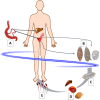Praziquantel for Schistosomiasis: Single-Drug Metabolism Revisited, Mode of Action, and Resistance
- PMID: 28264841
- PMCID: PMC5404606
- DOI: 10.1128/AAC.02582-16
Praziquantel for Schistosomiasis: Single-Drug Metabolism Revisited, Mode of Action, and Resistance
Abstract
Schistosomiasis, a major neglected tropical disease, affects more than 250 million people worldwide. Treatment of schistosomiasis has relied on the anthelmintic drug praziquantel (PZQ) for more than a generation. PZQ is the drug of choice for the treatment of schistosomiasis; it is effective against all major forms of schistosomiasis, although it is less active against juvenile than mature parasites. A pyrazino-isoquinoline derivative, PZQ is not considered to be toxic and generally causes few or transient, mild side effects. Increasingly, mass drug administration targeting populations in sub-Saharan Africa where schistosomiasis is endemic has led to the appearance of reduced efficacy of PZQ, which portends the selection of drug-resistant forms of these pathogens. The synthesis of improved derivatives of PZQ is attracting attention, e.g., in the (i) synthesis of drug analogues, (ii) rational design of pharmacophores, and (iii) discovery of new compounds from large-scale screening programs. This article reviews reports from the 1970s to the present on the metabolism and mechanism of action of PZQ and its derivatives against schistosomes.
Keywords: cytochromes P450; enantiomers; metabolism; praziquantel; schistosomiasis.
Copyright © 2017 American Society for Microbiology.
Figures





References
-
- World Health Organization. 2002. Prevention and control of schistosomiasis and soil-transmitted helminthiasis: report of a WHO expert committee: technical report series 912, p 2–5. World Health Organization, Geneva, Switzerland: http://apps.who.int/iris/bitstream/10665/42588/1/WHO_TRS_912.pdf?ua=1. - PubMed
-
- Hotez PJ, Alvarado M, Basáñez MG, Bolliger I, Bourne R, Boussinesq M, Brooker SJ, Brown AS, Buckle G, Budke CM, Carabin H, Coffenq LE, Fèvre EM, Fürst T, Halasa YA, Jasrasaria R, Johns NE, Keiser J, King CH, Lozano R, Murdoch ME, O'Hanlon S, Pion SD, Pullan RL, Ramaiah KD, Roberts T, Shepard DS, Smith JL, Stolk WA, Undurraga EA, Utzinger J, Wang M, Murray CJ, Naghavi M. 2014. The global burden of disease study 2010: interpretation and implications for the neglected tropical diseases. PLoS Negl Trop Dis 8:e2865. doi:10.1371/journal.pntd.0002865. - DOI - PMC - PubMed
Publication types
MeSH terms
Substances
Grants and funding
LinkOut - more resources
Full Text Sources
Other Literature Sources

